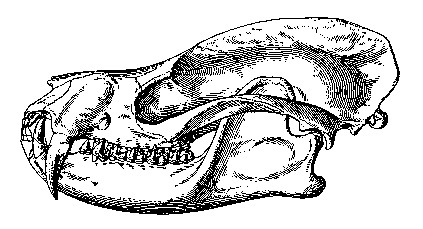
by Martin Jehle

Skull of Deltatherium fundaminis, one of the first Paleocene mammals described from North America (see here for a restoration). Its relationships are still debated. From Williamson (1996).
Mammals appear first in the late Triassic, at about the same time as dinosaurs. Throughout the Mesozoic, most mammals were small, fed on insects and lead a nocturnal life, whereas dinosaurs were the dominant forms of life on land. This situation changed abruptly about 65 million years ago, when dinosaurs disappeared with the exception of their descendants, the birds, probably as the result of a meteorite impact. At the beginning of the Paleocene epoch, the world was practically without larger sized terrestrial animals. This unique situation was the starting point for the great evolutionary success of the mammals. Only ten million years later, at the end of the Paleocene, they had occupied a large part of the vacant ecological niches. By this time, the landscape was teeming with small insectivorous and rodent-like mammals, medium sized mammals were searching the forests for any kind of food they could cope with, the first large (but not yet gigantic) mammals were browsing on the abundant vegetation, and carnivorous mammals were stalking their prey.
Despite this impressive diversification, most Paleocene mammals are still on a primitive level of anatomy in comparison to mammals of today. Often they show only the first beginning of specializations that characterize their descendants from later epochs, such as optimization of the teeth for a special kind of food or adaptations of the limbs to fast running. The Paleocene mammalian fauna is therefore often called archaic. The beginning of the following epoch, the Eocene, brought about an important modernization of this fauna. Several groups of mammals with more modern appearance spread over the northern hemisphere at this time, whereas the decline of the archaic forms started.
The Paleocene is a crucial time in the history mammals. Unfortunately, mammal fossils from this epoch are either scarce or entirely unknown in many parts of the world. Thus we can only speculate how the fauna of whole continents looked after the extinction of dinosaurs. Even where fossils occur, most species are only known from their characteristic teeth, and skeletons are only known for a few forms. Nevertheless, knowledge of Paleocene mammals is steadily increasing. This website tries to summarize what we know about these first ten million years of the age of mammals.
Contact me if you have any comments or suggestions.